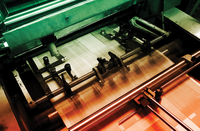Hot off the press
Printing firms currently market their services on the Internet and printing has never been cheaper. Linux provides two programs, Inkscape and Scribus, that together produce high-quality print artwork.
|

Guy Shapira, 123rf.com
Printing firms currently market their services on the Internet and printing has never been cheaper. Linux provides two programs, Inkscape and Scribus, that together produce high-quality print artwork.
Most professional print products are created in Adobe's InDesign, Illustrator, and Photoshop products. However, the free Scribus [1] and Inkscape [2] application offer alternatives with which you can create technically flawless artwork for offset printing.
Inkscape is still the most useful vector graphic program for design purposes. It provides a wide variety of tools and effects that give you the creative flow you need. You can also use it to integrate external bitmaps and texts.
Figure 1 shows the design for a CD cover in Inkscape. At the top, you can see the preparation for print setup that is used during the design for page size. The three millimeters wide red border is the so-called bleed that falls away during the sheet cutting. Because of the tolerances of the cutting machines, the design in this regard needs to proceed flawlessly.
[...]
Pages: 4
The Inkscape vector graphics program not only lets you work with pencil and ink lines, it can help you mimic the elegant brushstrokes of an oil painting. Our three easy-to-follow examples show you how.
Photivo closes the gap between RAW converters and easy image editing, thus making often required reworking in other programs unnecessary.
The open source DTP software Scribus is back on the stage with a much improved import capability for file formats and many more functions for use in the professional realm. The beta version discussed here promises good things for the future.
Besides basic drawing functions, Inkscape provides sophisticated effects that can transform vector lines into soft, flowing brushstrokes or automate the drawing of paper-fine lines.
The program OpenSCAD makes it possible to construct 3D objects via just a few commands. STL Exporter makes the software interesting for users who have a 3D printer.
© 2026 Linux New Media USA, LLC – Legal Notice